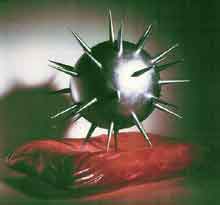HIV Infection Cycle
- HIV's attack helper T cells by attaching to the
cell. via CD4 proteins in their cell
 membrane tl. Normally, these proteins bind to antigens to activate
of the helper T cells. This allows them access to the T4 lymphocyte.
membrane tl. Normally, these proteins bind to antigens to activate
of the helper T cells. This allows them access to the T4 lymphocyte.
- Once the virus has attached to a helper T cell,
it injects its genetic information (as RNA) into the cell,
along with the enzyme reverse transcriptase.
- Reverse transcriptase catalyzes the
production of DNA from the viral RNA, making a DNA copy of the virus's
genetic material. This DNA copy is capable of
incorporating itself into the cell's genetic material, because it is now
in the same form as the cell's chromosomes.
The step catalyzed by reverse transcriptase is one of the most important
steps in the infection cycle.
- The viral DNA copy then enters the
nucleus of the infected helper T cell, where it is incorporated into the
cell's genetic material (i.e., the chromosomes).
- Using the cell's own DNA-replication
mechanisms, the viral DNA replicates.
- Using the cell's mechanisms for producing
proteins from the genetic information contained in DNA, many
copies of the proteins needed by the virus are made from the replicated
HIV DNA. As part of this step, RNA copies of the viral DNA are
made.
- When they are first synthesized, the proteins are
too long (containing extra fragments) to be assembled into new viruses.
They must be cut to their proper size. The HIV enzyme
protease, which is produced by the cell's biochemical
machinery from the viral DNA incorporated into the cell's chromosomes,
catalyzes the cutting of these proteins to their proper size.
- New HIV particles (viruses) are assembled
inside the cell from the cut viral proteins and the viral RNA copies.
- Once assembled, the new viruses then
burst out of the host cell (killing it) and invade new cells,
continuing the infection.
Enzymes play a vital role in HIV's attack on
helper T cells.
A DNA copy of the viral genome by reverse transcriptase (Step 3) and the
cleavage of viral proteins (Step 7) by protease are two important
processes catalyzed by enzymes.
Therefore, the enzymes reverse transcriptase and
protease are major target sites for HIV-fighting drugs.
Any nucleotide analogue that can be inserted into
the replicating DNA.
Thymine is the nucleotide of choice and has been made into AZT /
Zidovudine/
By competitive inhibition of
reverse transcriptase
and or protease
the viral ability to replicate is
diminished thus not eliminating AIDS but controlling the activity of the
HIV virus.
after
http://www.chemistry.wustl.edu/~edudev/LabTutorials/HIV/DrugStrategies.html
|